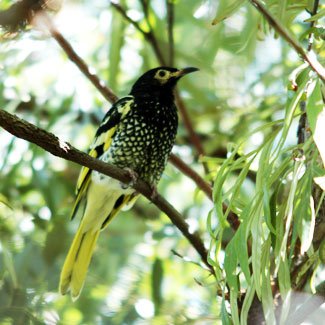Saviour of a species

FIFTEEN YEARS AGA, a tiny native Aussie bird faced extinction as its habitat was cleared at an alarming rate.
At the same time, Ray Thomas, the 2009 Australian Geographic Conservationist of the Year, saw an area of Australian woodlands in desperate need of protection.
The regent honeyeater, Xanthomyza phrygia — a tiny black and gold bird native to Australia — was once found in great numbers throughout the box ironbark forests of NSW and Victoria. These eucalypt forests, with canopies that can grow up to 25 m high, have been subjected to intense forestry. About 85 per cent of box ironbark forests in Victoria have been cleared since European settlement.
As a result, numbers of the endangered regent honeyeater are currently estimated at as low as 800 individuals nationally.
At around the same time that Ray was beginning a mammoth project to replenish Australia’s box ironbark forests, 10 of these diminutive honeyeaters were relocated from their homes to Taronga Zoo in Sydney, destined to become among the saviours of their species.
The birds that were taken to Taronga in 1995 have since become the proud parents, grandparents and possibly great-grandparents of more than 30 chicks.
Meanwhile, Ray, along with the help of thousands of volunteers, planted 385,000 seedlings during this period and saw areas of vegetation return to their former beauty. Dense forests that could soon be home to native animals were restored through the cooperation of local farmers, schools and communities.
“THIS YEAR, THERE have been fewer sightings of regent honeyeaters in the wild than ever before,” says Taronga bird keeper Michael Shield. “In a hope to reverse this trend, we are currently pairing up adult birds and providing them with the optimum conditions to welcome hatchlings into the world.”
It is hoped that up to 100 birds will be released in to the wild in Victoria this year. With radio transmitters fitted to their tails or onto their backs, the movements of these tiny migratory birds will be tracked as they nest high above the ground or search for food among their newly replenished, flowering eucalypt homes.
“We try to make sure that the birds bred at the zoo are as close to their wild cousins as possible,” Michael said. “To ensure that they don’t have a ‘zoo accent’ we have been playing them callings from birds living in the forests where they will be released — in the hope they will not only act and look the same, but also sound the same.”
The survival of these species relies on more than just the breeding program. Ray and his community of volunteers are working overtime to ensure that the ecosystem that sustains these tiny birds does not go into decline.
The regent honeyeater breeding program is one of many projects supported by the Taronga Foundation during 2010 for the international Year of Biodiversity. National volunteer programs for 2010 are listed here.
LINKS
The regent honeyeater breeding program at Taronga Zoo
The International Year of Biodiversity
2009 AG Conservationist of the Year: Ray Thomas

